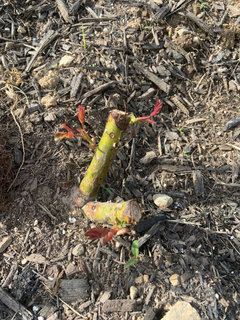ROSE ROSETTE DISEASE
GardeningTeenager
last year
Featured Answer
Comments (29)
GardeningTeenager
last yearRelated Discussions
presence of Rose Rosette Disease on the climbing roses at the Ral
Comments (1)Oh, that is so sad to hear. I hate this stuff! I wonder if there will ever be a treatment for it, besides removal, that works....See MoreConfirmed cases of Rose Rosette Disease in my DFW area roses
Comments (18)I'm new to roses (planted my first rose garden in 2011) and, thus far, they're all healthy, but I do read a lot and want to be educated and ready to remove plants if it becomes necessary. I saw my first RRD rose at my local independent nursery a few days ago. A landscaper had brought in a branch and blooms. The horticulturist on staff at the nursery was kind enough to gather a few of us around and point out what to look for. In all honesty, it looked really different in person than what I had here-to-then seen online and read in descriptions of the virus. It was really helpful to see the "witch's broom"-like growth, the blooms that looked like it was grown at a leaking nuclear plant, and the weird thorniness that were like thorn-hair. This particular afflicted plant was off a Knockout variety but I know it can affect all roses, so I'm watching everything at my house, praying that I don't have to "euthanize" any. Pretty scary. Wish there was something we could do to avoid it. Makes you feel so helpless. . ....See Morerose-rosette-disease-symposium-the-american-rose-center
Comments (0)See: https://www.eventbrite.com/e/rose-rosette-disease-symposium-the-american-rose-center-tickets-49415018651...See MoreRose Rosette Disease: A Threat to Kentucky Roses
Comments (0)See: [https://kentuckypestnews.wordpress.com/2019/08/20/rose-rosette-disease-a-threat-to-kentucky-roses/?ct=t(RSS_EMAIL_CAMPAIGN](https://kentuckypestnews.wordpress.com/2019/08/20/rose-rosette-disease-a-threat-to-kentucky-roses/?ct=t(RSS_EMAIL_CAMPAIGN)...See MoreBenT (NorCal 9B Sunset 14)
last yearlast modified: last yeardianela7analabama
last yearlast modified: last yearAshley Smith zone 5a
last yearlast modified: last yearseasiderooftop
last yearKristine LeGault 8a pnw
last yearlast modified: last yearGardeningTeenager
last yearerasmus_gw
last yearrifis (zone 6b-7a NJ)
last yearGardeningTeenager
last yearseasiderooftop
last yearerasmus_gw
last yearsummercloud -- NC zone 7b
last yearGardeningTeenager
last yearGardeningTeenager
last yearSteve_M in PA
last yearerasmus_gw
last yearsubk3
last yearlast modified: last yearsubk3
last yearSheila z8a Rogue Valley OR
last yearMischievous Magpie (CO 5b)
last yeardianela7analabama
last yearlast modified: last yearSteve_M in PA
last yearcharles kidder
last year
Related Stories

GARDENING GUIDESGreat Design Plant: Knock Out Roses
As glorious as their high-maintenance kin for a fraction of the work, Knock Out roses make even beginners look like garden stars
Full Story
GARDENING GUIDESWhat Kind of Roses Should You Grow?
Want to add the beauty of roses to your garden? Find out which ones, from old-fashioned to modern, are right for you
Full Story
GARDENING GUIDESLearn the Secret to Bigger and Better Roses
Grow beautiful roses using both ordinary and unusual soil amendments
Full Story
GARDENING GUIDES5 Sweet to Spirited Pink Roses for an Enchanting Garden
Whether you go demure or daring, there's a pink rose here to make you flush with garden pride
Full Story
GARDENING GUIDESRoses: Crowning Touch of Gardens
Whether you're the Miss or Mister America of gardening or take a hands-off approach, roses can be a winning addition to your landscape
Full Story
GARDENING GUIDESGreat Design Plant: Rosa Banksiae a Low-Maintenance Beauty
This thornless, disease- and insect-resistant rose brings showers of white or yellow flowers to the spring garden
Full Story
GARDENING GUIDES6 Wonderfully Easy Roses for Any Gardener
Look like an expert even if you're just starting out, with these low-maintenance gems of the rose world
Full Story
SPRING GARDENINGHow to Grow a Rose Garden in Pots
Everything can come up roses, even without a plot of soil in sight. This step-by-step guide to growing roses in containers shows you how
Full Story
SPRING GARDENING5 Exotic Rose Colors for a Beautifully Different Garden
Give red a rest. Let these daring hues take the spotlight instead for a rose garden that turns heads
Full StorySponsored
More Discussions






BenT (NorCal 9B Sunset 14)